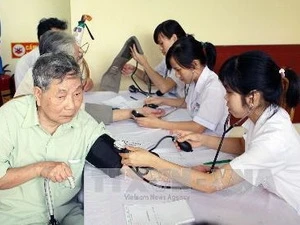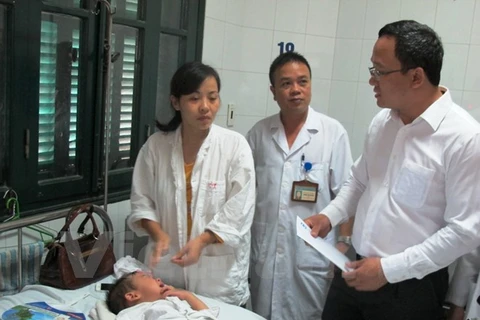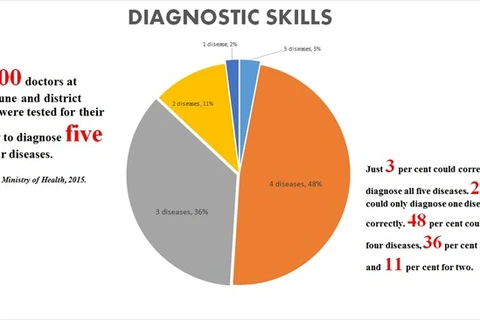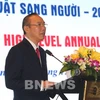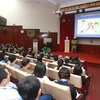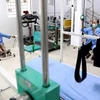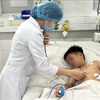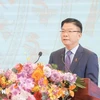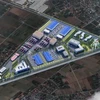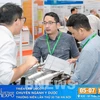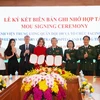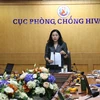Hoi An (VNA) - The central province of Quang Nam is struggling to recruit doctors for public hospitals and clinics because of low pay and tough working conditions.
At the General Hospital in the tourist hotspot of Hoi An city, there are not enough doctors to serve local patients, with only six being hired under a three-year (2013-2015) provincial programme.
Nguyen Van Dung, Chairman of the Hoi An People’s Committee, told Vietnam News that the city needs to hire another 10 doctors.
“The city hospital – a major health centre for local residents – has a total of 22 doctors, but only 16 are on duty for daily health examinations,” Dung said.
He said the city plans to have doctors and nurses from local heath centres work at the hospital to ease the overload on existing staff.
Hospital director Dinh Thi Thu Huong said only a third of its doctors had to provide medical examination to 400 patients each day.
“Three doctors have to cover administrative tasks, while one has been assigned to working on Cham Island. Five doctors are in charge at paediatrics and obstetrics wards and others have to take time off after night duty,” Huong said.
“The hospital has had to employ retired doctors or urge doctors not to take days off,” she said.
Huong said many doctors have reached retirement age, and several prefer to work at private hospitals or heath centres for better payment.
She said an experienced doctor can earn 40 million VND (1,800 USD) a month at a private hospital, while they were paid just 5.4 million VND (238 USD) at a State-owned hospital.
She complained that young doctors received just 2 million VND (88.5 USD) – even lower than old nurses, and the salary policy did not encourage young doctors to work at a hospital for long time.
The director also said some doctors left the hospital for private employment two or three years after they were funded to attend short-term training courses.
Huong said a doctor working at the State-run hospital only got 50,000 VND (2.2 USD) for a night duty, while they could earn nine times as much at a private hospital.
In the mountainous Nam Tra My district, there are 17 doctors on the rolls, but just four serve at 10 health centres.
Director of the district’s health centre Tran Van Thu said most doctors in the district were from ethnic minority communities with limited knowledge and skills.
He said it was risky to transport patients who needed emergency care to the provincial hospital around 100km away.
Another mountainous district, Phuoc Son, has 33 doctors covering 12 rural communes with poor traffic, medicines and equipment.
Tam Ky city’s North Quang Nam general hospital also needs to employ 50 doctors to provide health care services to 700 patients who come for health examinations each day, apart from 1,000 inpatients.
Nguyen Van Hai, director of the provincial health department, said Quang Nam had allocated a budget of 105 billion VND (4.6 million USD) for the 2013-2015 period to hire 135 doctors to work at health centres and hospitals across the province.
“The province offered them (doctors) from 200 million VND (8,800 USD) to 500 million VND (22,000 VND) (per year) each to get them to work in the province, and an additional 100 million VND (4,400 USD) for accommodation,” Hai said.
The province currently has 947 doctors, 891 of whom work at State-run hospitals, for a ratio of 6.3 per 10,000 people.
However, 95 percent of doctors preferred to work at hospitals and health centres in cites and districts, and only five percent agreed to work in rural and mountainous areas.
Hai said the province also planned to employ 500 doctors with similar preferential policies over the next five years (2017-2021) to try and make up the human resources shortage in the health sector.
As planned, the province will have more than 1,300 doctors by 2020, and a lot of money is needed to hire them, he added.-VNA
At the General Hospital in the tourist hotspot of Hoi An city, there are not enough doctors to serve local patients, with only six being hired under a three-year (2013-2015) provincial programme.
Nguyen Van Dung, Chairman of the Hoi An People’s Committee, told Vietnam News that the city needs to hire another 10 doctors.
“The city hospital – a major health centre for local residents – has a total of 22 doctors, but only 16 are on duty for daily health examinations,” Dung said.
He said the city plans to have doctors and nurses from local heath centres work at the hospital to ease the overload on existing staff.
Hospital director Dinh Thi Thu Huong said only a third of its doctors had to provide medical examination to 400 patients each day.
“Three doctors have to cover administrative tasks, while one has been assigned to working on Cham Island. Five doctors are in charge at paediatrics and obstetrics wards and others have to take time off after night duty,” Huong said.
“The hospital has had to employ retired doctors or urge doctors not to take days off,” she said.
Huong said many doctors have reached retirement age, and several prefer to work at private hospitals or heath centres for better payment.
She said an experienced doctor can earn 40 million VND (1,800 USD) a month at a private hospital, while they were paid just 5.4 million VND (238 USD) at a State-owned hospital.
She complained that young doctors received just 2 million VND (88.5 USD) – even lower than old nurses, and the salary policy did not encourage young doctors to work at a hospital for long time.
The director also said some doctors left the hospital for private employment two or three years after they were funded to attend short-term training courses.
Huong said a doctor working at the State-run hospital only got 50,000 VND (2.2 USD) for a night duty, while they could earn nine times as much at a private hospital.
In the mountainous Nam Tra My district, there are 17 doctors on the rolls, but just four serve at 10 health centres.
Director of the district’s health centre Tran Van Thu said most doctors in the district were from ethnic minority communities with limited knowledge and skills.
He said it was risky to transport patients who needed emergency care to the provincial hospital around 100km away.
Another mountainous district, Phuoc Son, has 33 doctors covering 12 rural communes with poor traffic, medicines and equipment.
Tam Ky city’s North Quang Nam general hospital also needs to employ 50 doctors to provide health care services to 700 patients who come for health examinations each day, apart from 1,000 inpatients.
Nguyen Van Hai, director of the provincial health department, said Quang Nam had allocated a budget of 105 billion VND (4.6 million USD) for the 2013-2015 period to hire 135 doctors to work at health centres and hospitals across the province.
“The province offered them (doctors) from 200 million VND (8,800 USD) to 500 million VND (22,000 VND) (per year) each to get them to work in the province, and an additional 100 million VND (4,400 USD) for accommodation,” Hai said.
The province currently has 947 doctors, 891 of whom work at State-run hospitals, for a ratio of 6.3 per 10,000 people.
However, 95 percent of doctors preferred to work at hospitals and health centres in cites and districts, and only five percent agreed to work in rural and mountainous areas.
Hai said the province also planned to employ 500 doctors with similar preferential policies over the next five years (2017-2021) to try and make up the human resources shortage in the health sector.
As planned, the province will have more than 1,300 doctors by 2020, and a lot of money is needed to hire them, he added.-VNA
VNA

